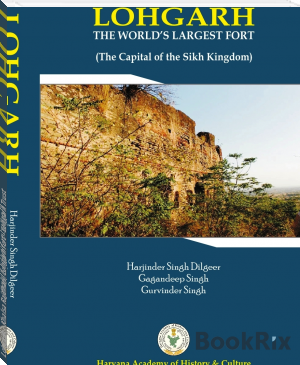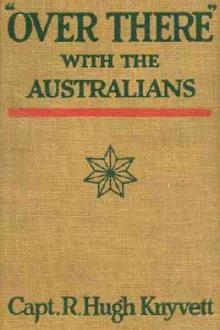Lohgarh - Khalsa Rajdhani, Lohgarh fort - Lohgarh Trust by S. Daljeet Singh Bajwa (books that read to you .TXT) 📕

- Author: S. Daljeet Singh Bajwa
Book online «Lohgarh - Khalsa Rajdhani, Lohgarh fort - Lohgarh Trust by S. Daljeet Singh Bajwa (books that read to you .TXT) 📕». Author S. Daljeet Singh Bajwa
The geographical location and topography of the Lohgarh area is such that here the siezure of Mughals also was not possible. This area, having high contours hills with undulated land with thorny forest covers
on one side, and steep rise of hills on other side, surrounded by seasonal rivulets flowing along with their foot, made it highly defensive. Bahadur Shah, the Mughal Emperor himself reached Lohgarh in 1710, to free this Fort from the Sikh army. After reaching this place, he realized the gravity of the situation, i.e. the defensibility and invincibility of the Fort, and, he was compelled to move back without capturing it. Now the fear of collapse of the vast Mughal Empire hovered over his mind as a result of which depression overwhelmed him due to which he became insane and died after some time.
For the construction of such a large Fort, a large number of men forces both skilled and unskilled i.e. in the shape of laborers, masons & architect were required. The Construction materials i.e. bricks, stone of different size, sand and crushed stone were the requirement a heavy demand; hence, the mission was supposed to be completed secretly without disclosing its objectives to the common man.
Remnants of Fortification Walls found at Lohgarh Fort
A systematic archaeological investigation of the site of the Lohgarh was conducted for months together and a large number of remnants pertaining to Fortification walls were found at Lohgarh. These Fortification walls bear the thickness from 3 to 4 meters. Such large and heavy Fortifications were done with anticipation of huge battle with the Mughals and the Sikhs had the information that the Mughals’ arsonary had the world’s best cannons including the small cannons which could be installed on the camels.
The Fortification wall was found around the Lohgarh Fort and this wall is made of Ashlar stone masonry using dressed blocks of given dimensions with faces perpendicular to each other and laid in the course by using lime motor as the binding materials. The masonry and the workmanship of the walls is wonderful.
The remains of the defense walls have been found in the Pahlori Reserve Forest. These archaeological evidences are located in the North east side of Fort Lohgarh. The back side of this area is a dense jungle, which has now been declared as the Sher Jung National Park. We can
make a walk of 10 km through the jungle from these archaeological evidences towards the northeast direction to reach Poanta Sahib. In the center, we find a place called Sukhchain Singh Tanda; there too archaeological evidences can be seen.
The foundation of a bastion is found at in sector 30 of Lohgarh Fort. Presently there are only two layers of stone left on the archaeological site. The rest of the structure was demolished by the Mughals. It can be safely presumed that there has been a continuous erosion of soil due to rains in the area and that erosion has uncovered the foundation of the Bastions in the course of 300 years. Each bastion is having the area of 50X50 ft.
Dregs of Parapets are found in sector 12 of Lohgarh Fort: This area is of strategic importance as it is situated near the forefront of the Fort. The thickness of the wall is about 3 to 4 meters. It is a masonry built of stones in regular shape and hammer dressed with comparatively thick joints and lime motor brick surkhi used as a binding material.
The blockage of stronghold found in the village of Nagli shows the archaeological evidences of the Fort Lohgarh. The stone masonry work was done here lime mortar. The contour of the said area is at hillock and for the enemy this rampart was a major hurdle for the army to reach the camping area of the Sikh soldiers. From this point only a few Sikh soldiers were able to confront the large Mughal army.
Heavy Fortification walls bearing thickness from 2.5 to 3 meters are found in sector 12 of Lohgarh Fort. This area is on the bank of Lohgarh khol and it was quite vulnerable to the Mughal attack in 1710. This area is flat from the front side having a big camping ground and the backside of this area is elevated and narrow, having a steep side and two khols touching both the sides flow and fall in the Lohgarh Khol. This area was a vintage point for the Sikh soldiers, it acted as a supply depot for the Sikh soldiers fighting in the front against the Mughal army. The tail of this Fortification touches the sector C-4 of Haripur reserve forest which was a very safe and invincible.
The remnants of ramp and strong hold lead to the hillock of reserve forest of Jhanda village of Haryana are found. After making the
archaeological survey of the area a dual Fortification of the hills can be seen and from here a vast view of the plains, i.e. the battlefield of the Lohgarh; and, some of the 52 bastions of Fort Lohgarh were easily visible. The siezure of this area was not possible as there are steep hills and adjoining these hills the river Markanda flows. The supplies for the Sikh army were made from the back side of the Fort, which is adjacent to Nahan.
Remnants of Stone Barricades are found in the Nanhari reserve forest. This area is in the South east part of the Fort Lohgarh and is situated on the attacking site of the Fort. Geographically, this area is situated between the khols and a pass leading to Jafarpur Jafri village of Haryana.
Archaeological evidences are found in the reserve forest of Kotla. At the hillock of Kotla and the adjacent area of Himachal Pradesh there is a heavy Fortification on the hills and parts of Chakki are found here. It shows that the kitchen of the Sikh soldiers was on the high contours, so that the food supplies and other basic amenities remained away from the attack of the Mughals.
In the revenue state of Sangholi, on the higher contours, a random rubble masonry Fortification is found with stones of different sizes and shapes brought from the quarry of a bed of a rivulet flowing adjacent to the area. Lime motor and surkhi was used as the binding material. This area had a multi Fortification system as it was on the fore front of the Fort and these are vulnerable to the aggression by Mughal canons. The historian Dr. Harjinder Singh Dilgeer along with S. Jarnail Singh, during his visit to Lohgarh, inspected the bastion and a watch tower in sector 16 of Lohgarh Fort. On the foundation of the bastion, as found in sector 16 Lohgarh Fort, presently there are only two layers of stones left on the archaeological site. The rest of the structure was demolished
by the Mughals.
During their visit to sector C-2 of Lohgarh Fort, they found that this sector is about 10 km deep inside the Fort and this is quite far away from the forefront of the Fort. The supply depot of the Sikh army has been found here.
Dregs of the parapets have been found in sector 17 of Fort. This area is of strategic importance as it is situated near the forefront of the Fort. Here the thickness of the wall is about 2 to 2.5 meters. It is masonry built of stones in regularly shape as quarried or squared and hammer dressed and having comparatively thick joints of lime motor having brick surkhi.
As far as Lohgarh Fort is concerned, only a rich person like Lakhi Rai Vanjara could have built it. He had a force of hundreds of thousands of young workers (who had military training as well). A huge quantity of stones, lime and bricks were used to build this Fort. Such massive stock of construction materials could not have been brought by a couple of hundred persons. A ‘tanda’ (trade caravan) of hundreds of thousands or person would have brought all this. Lakhi Rai Vanjara already had experience of building about two dozen Forts and Palaces. He had been a supplier of building materials (stone, lime and timber) for the Red Fort Delhi and some Maratha Forts.
Endnotes
Research Report, prepared by Indian Trust, for Rural Heritage and Development, New Delhi, (2016), page Page 169; The Crisis of empire in Mughal North India, by Muzaffar Alam, ISBN13:978-0-19-807741-6 & ISBN10:0-19-80741-6. Ibid page 160-74 Andrea Hintze, Mughal Empire and its Decline: An Interpretation of the Sources of Social Power, 62.
Chapter 3
Founding of Lohgarh Fort
The idea of Lohgarh Fort was conceived by Guru Hargobind Sahib during his imprisonment in the Gwalior Fort. Guru Hargobind spent about six and a half years (1613 to 1618) in Gwalior Fort prison. This prison was reserved for exceptional persons (especially defaulter taxpaying rulers, state officials, opponents of the state or rebels) and non-Muslim religious personalities. At the time of the imprisonment of the Guru, 101 rulers, princes, chiefs, chieftains, feudals, landlords, state officials and other prominent persons had been interned in Gwalior Fort. They had been interned for non-payment of taxes or for disobeying one or another command of the Emperor. They included Kalyan Chand and his son Tara Chand (the ruler of Kehlur/ Bilaspur state), Hari Chand (the rulers of Handur/ Nalagarh state) and others from hilly or Rajputana states. Before the arrival of the Guru, these prisoners had been living in a state of anxiety, despondency and helplessness. When the Guru reached there, he began daily keertan (singing of hymns) and religious and philosophical discourses. The Guru gave them confidence and made them cheerful. Those who were feeling despondent and helpless and suffering from the problem of psychosis began living in hope and high spirits. They became devotees of the Guru. It seems that here the Guru might have planned to build a very powerful Fort to ensure a defense system to face the Mughal Empire. Lohgarh Fort seems to be a part of this strategy.
Release of Guru Hargobind Sahab and the Heads of the States
In 1618, Murtaza Khan the Governor of Lahore died. In the meanwhile,
Wazir Khan of Chiniot (later Governor of Lahore) had become a favorite courtier of Jahangir; almost during the same time Jahangir had a meeting with Mian Mir. Both of them (Wazir Khan and Mian Mir) requested Jahangir to release Guru Hargobind; Jahangir’s beloved wife Nur Jahan too impressed upon him to accept their advice and release the Guru. By this time, Jahangir too had become free from the influence of the fanatical Muslim clergy (including Sheikh Ahmad Sarhandi); all this made Jahangir to issue orders for the release of Guru Sahib.
The orders of the release of Guru Sahib were delivered by Wazir Khan himself. When the other royal prisoners came to know of the release of Guru Sahib, they became very sad and some of them began weeping also. Daily discourses of the Guru had changed their lives and they had begun living in high spirits. Guru Sahib decided to help them. He told Wazir Khan: ‘I will leave the prison only if other prisoners too are released.’ Wazir Khan promised to approach the Emperor; and when Wazir Khan met Jahangir and informed him about the Guru’s wish, the Emperor was very much impressed. He ordered that those prisoners who had been given short sentences (one to two years) be released and from amongst the rest all those would be released who clung to the Guru’s cloak. Jahangir, perhaps, wanted to test as to whom the





Comments (0)